European Tour 2008 - Museums
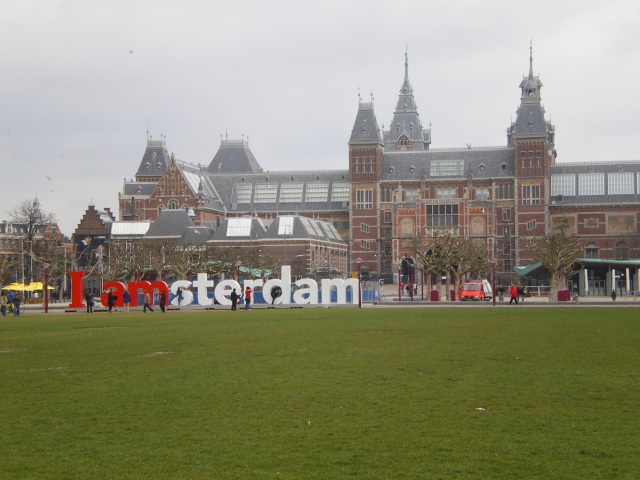 |
Amsterdam April 2008 Photo of the Rijksmuseum taken from across the Museumplein. This place surely has more Rembrandts than any other. Most famous is the Night Watch. They claim to have four Vermeers, but I counted only three. They were familiar images, but the pictures were smaller than I expected. |
 |
Amsterdam April 2008 The Van Gogh museum, devoted to a single artist, is a top tourist attraction in Amsterdam. There are three floors showing dozens of originals as well as numerous paintings by artists who influenced and were influenced by Van Gogh, including Monet, Pissarro, and Toulouse-Lautrec. Organization and presentation of art and exhibits are superb. Notable paintings by Van Gogh include The Potato Eaters and Bedroom at Arles. I was startled by a small painting of a skeleton smoking a cigarette. It looked like an anti-smoking poster from the 1990's. Was Van Gogh's brain operating a hundred years ahead of his time? Maybe that was why he seemed insane. |
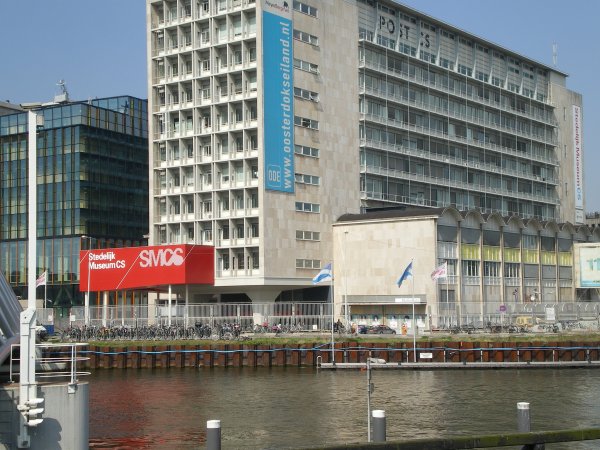 |
Amsterdam April 2008 The Stedelijk (pronounced stay-duh-lick) is one of three premier art museums in Amsterdam. (The others being the Van Gogh museum and the Rijksmuseum.) It is temporarily housed in this building near the central station while construction of a new building proceeds near Museumplein. At the temporary site there are no works produced before 1960. So that excludes all the big name artists like Matisse. Much of the art on display here is social commentary, some of it in the form of film. I found a lot of it quite arresting. |
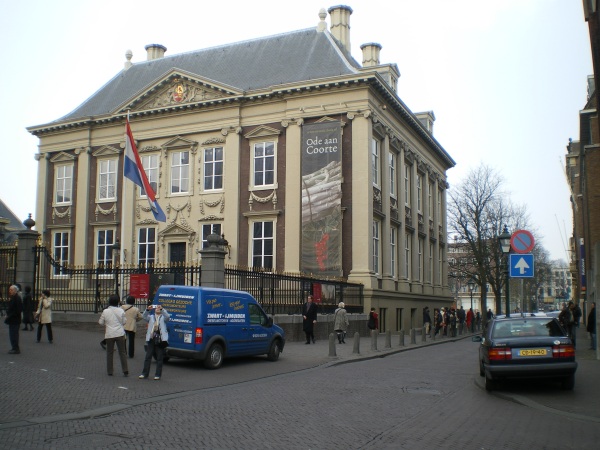 |
The Hague April 2008 The Mauritshuis (pronounced moritz-hice) Museum. I'd never heard of it before I came to the Netherlands, but it's one of the finest art museums in the world: rather small, but the quality of works displayed is extraordinary. Rubens, Rembrandt, Vermeer, and Steen are well represented. Most famous works: Anatomy Lesson by Rembrandt and Girl with the Pearl Earring by Vermeer. I was blown away by a Rubens painting of a young boy and an old woman with their faces illuminated by a candle. Three of the 37 (or is it 31?) Vermeers known to exist are in this museum. There was heavy security presence near the museum: a lot of suited guys with sunglasses and walkie-talkies scanning the crowds. I noticed there were about 10 stationary cars with drivers sitting in them or milling about. These were not taxis, but cars with their drivers waiting for passengers to appear. Then I realized the museum is next door to the Netherlands' Binnenhof, or parliament house. Apparently the parliament was in session and the drivers were waiting for high ranking government officials or politicians. It reminded me of the opening scenes from the film Day of the Jackal. |
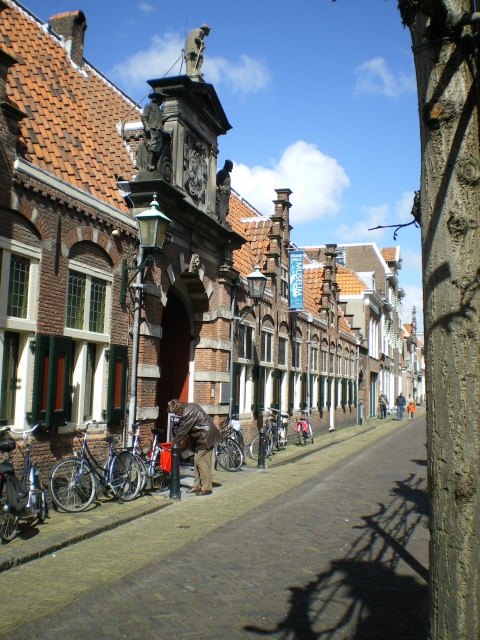 |
Haarlem, The Netherlands April 2008 Entrance to the Franz Hals museum. It has a permanent collection of Haarlem-related paintings from the Dutch golden age (i.e. the 1600's). When I was there it had a temporary exhibition of the works of the deBray family (father Salomon and sons Jan, Joseph and Dirick). Dirick did mostly still lifes (flowers, etc.) and the others did (1) biblical and religious stuff, (2) mythological stuff and (3) portraits of people singly or in groups. |
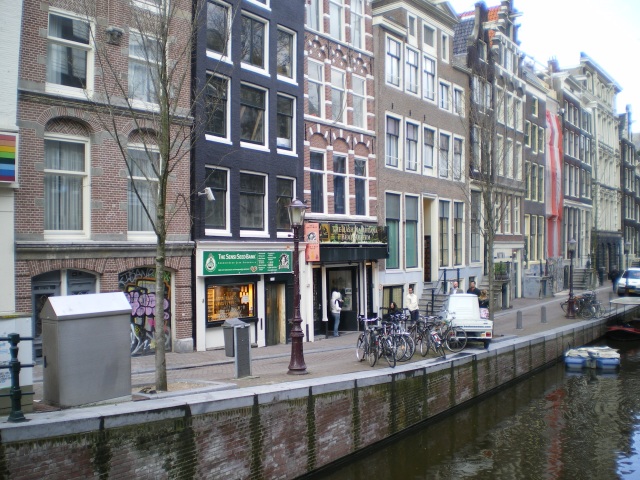 |
Amsterdam April 2008 Entrance to the Hash, Marijuana and Hemp Museum located at the south end of the red light district. Themes are (1) history of marijuana, (2) biology and cultivation of marijuana and hemp, (3) medical value of marijuana, (4) history and uses of hemp and (5) the insanity of anti-marijuana and anti-hemp laws. Museum displays an article in which Jimmy Carter states that federal laws against possession of less than 1 oz. of marijuana should be repealed. Carter says something to the effect that the damage from the punishment should not exceed the damage from using of the drug. |
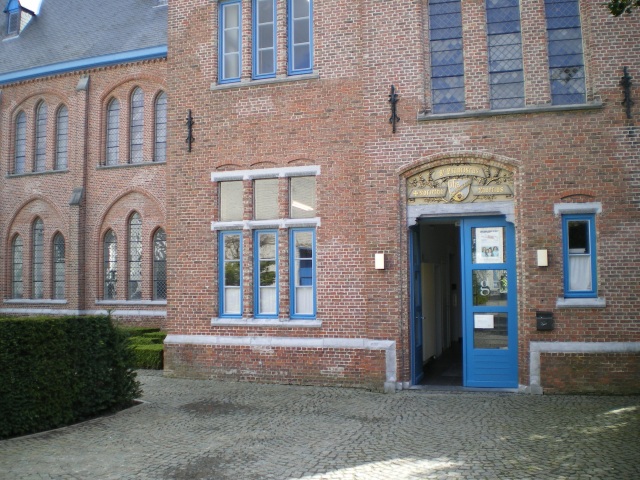 |
Bruges, Belgium April 2008 Groeninge Museum, home to some paintings by the Flemish Primitives, such as Jan van Eyck and Hans Memling, and some Flemish moderns as well, such as Magritte and Delveaux. |
 |
Bruges, Belgium April 2008 Chocolate Museum. Did you know that cocoa beans were once used as money? Considering the recent debasement of the dollar by U.S. authorities, perhaps we should return to that practice. Chocolate is just about pure saturated fat. But the Museum argues that chocolate is actually good for your health. I'm not convinced. |
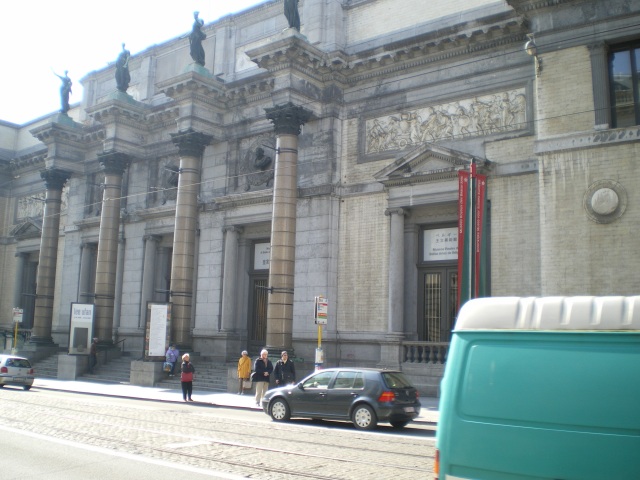 |
Brussels April 2008 Belgian Musee d'Art Moderne and Musee d'Art Ancien. The two museums are in the same huge building. There are two floors above ground and about five below. The Breughel family is well represented as are the modern artists Renee Magritte and Paul Delvaux. Viewing Jacques-Louis David's original Death of Marat is worth the price of admission. |
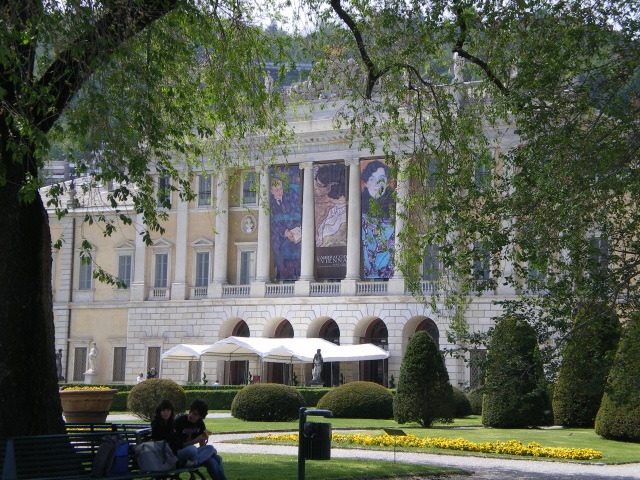 |
Como, Italy May 2008 "Embrace of Vienna" exhibition at the Villa Olmo on Lake Como. On display were paintings by Vienese artists from the late 1700's to the mid 1900's. Artists represented included Egon Schiele, Gustav Klimt, Oskar Kokoschka, Martin van Meytens, Franz Messerschmidt and Johann Baptist Reiter. I knew about Klimt, but was unfamiliar with the others. Seemed like an impressive display to me. Noteworthy was a very large painting, about 15 feet wide by 10 feet tall by Maximillian Oppenheimer entitled "Gustav Mahler conducts the Vienna Philharmonic". This was painted sometime between 1935 and 1952. |
 |
Paris May 2008 Entrance to the Louvre. The Louvre, limited to works created before 1848, is the world'd greatest art museum. The glass pyramids, which act as skylights for the rooms below ground, have been constructed since I spent two full days in the museum in 1968. So, having already visited the Louvre, and feeling I didn't have the time to to give its collections the attention they deserve, I passed it by in 2008. I have read that the crowds have gotten much larger in recent years, especially since the publication of The DaVinci Code. |
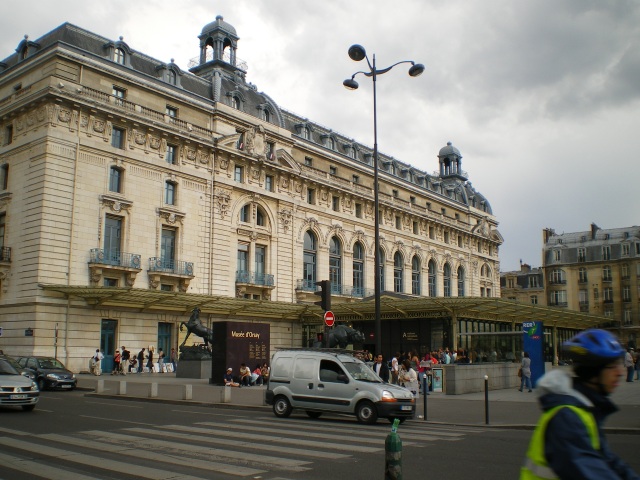 |
Paris May 2008 Musee d'Orsay The d'Orsay is the complement to the Louvre: all works exhibited were produced after 1848. It has the world's best display of impressionist and post-impressionist paintings. If the Louvre is the world's greatest art museum, then the d'Orsay may be the second greatest. Well, it's at least in the top five. The museum building was constructed in the 1980's, replacing a train station. |
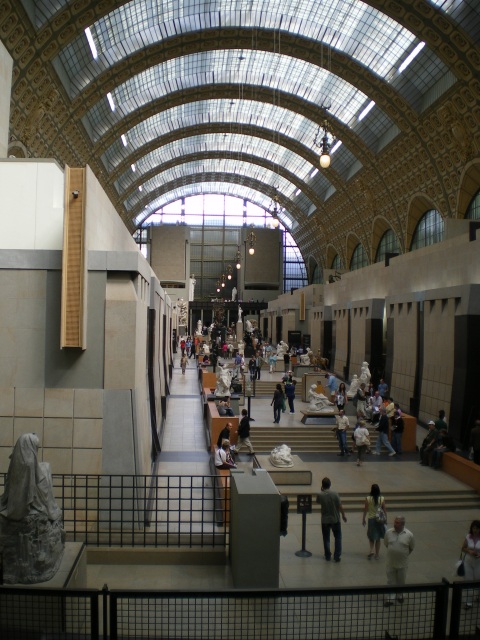 |
Paris May 2008 Central hallway in the d'Orsay. Architectural design is impressive. Note how natural light illuminates much of the room. Non-flash photography is permitted, but the no-flash rule is frequently violated, apparently because visitors don't know how to disable the flash on their point-and-shoot cameras. The quality of the museum experience is somewhat degraded by the large crowds of tourists and tour-groups, art classes and art copiers sprawled on the floor; also, by the street hucksters and beggars outside the doors of the museum. One disturbing development is the darkening of many canvasses. For example, Courbet's huge The Artist's Studio is now almost black. What causes the paintings to go dark? Can the original colors be recovered? Is anybody concerned about this? |
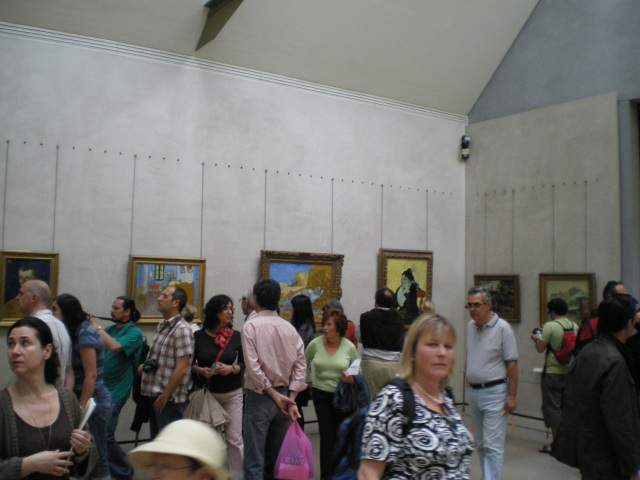 |
Paris May 2008 A room full of Van Goghs at the d'Orsay. Note the Bedroom at Arles (partly obscured by a man's head), another version of which is in the Van Gogh museum in Amsterdam. Nearby rooms are filled with the works of Cezanne, Gauguin, Degas, Manet, Renoir, Ingres, Toulouse-Lautrec, Monet and others. |
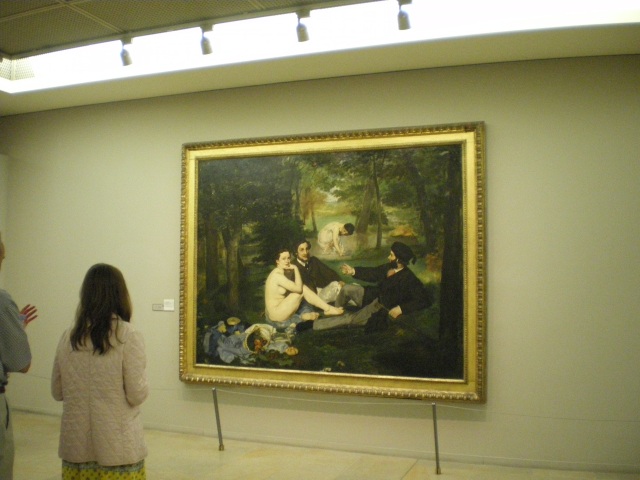 |
Paris May 2008 Le Dejeuener sur l'Herbe by Edouard Manet in the d'Orsay. I first saw this painting when I visited Paris in 1968 and it was housed in another building. Although familiar with the image from books, I had not realized the figures were life-sized. My reaction, upon walking into a room and seeing it for the first time, was to feel slight embarassment for intruding on a picnic where two well-dressed men are engaged in earnest conversation, one woman is washing herself in the stream and another woman--who is sitting stark naked--is looking directly at the viewer, as if asking, "Well, who are you and what are you doing here?" Meanwhile, I was wondering, as every viewer must, "What the heck is going on with these people?" |
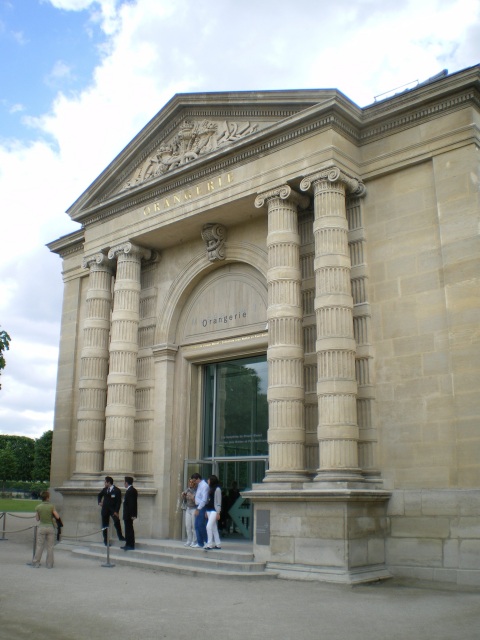 |
Paris May 2008 Musee de l'Orangerie. This nearly new museum is at the opposite end of the Tuilleries from the Louvre, across the Seine from the d'Orsay and very close to the Place Concorde. It has two floors. The top floor has two elliptical rooms especially designed to house eight of Monet's Nympheas (Water Lilies) canvasses. These rooms are illuminated primarily by large skylights. The bottom floor contains a collection of impressionist, post-impressionist, fauvist and expressionist paintings assembled by art dealer and promoter Paul Guillaume (1891 - 1934). |
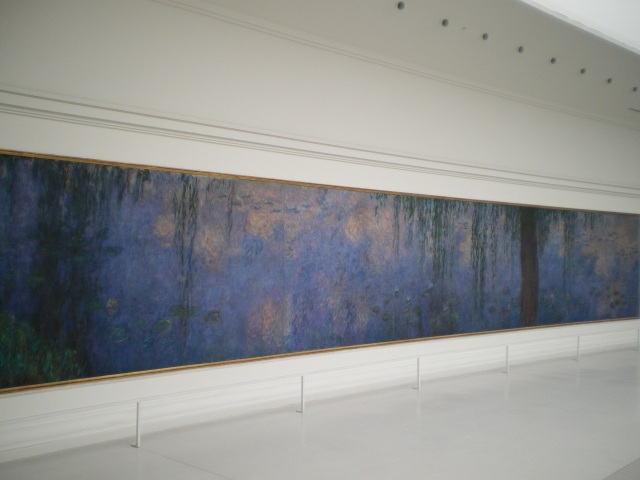 |
Paris May 2008 Monet's Water Lilies in the Orangerie museum. |